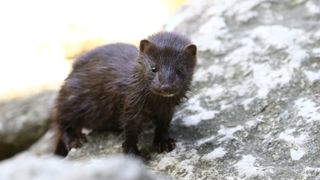If the virus circulates widely in wild animals, that could pose a significant danger to humans.

(Image: © Shutterstock)
By Nicoletta Lanese - Staff Writer 3 days ago
A wild mink in Utah tested positive for SARS-CoV-2, the virus that causes COVID-19, and it may be the first "free-ranging, native wild animal" with a confirmed coronavirus infection, according to the U.S. Department of Agriculture (USDA).
There's no evidence that the virus spread further than this one infected mink, but if SARS-CoV-2 begins circulating among wild animals, that could place humanity at risk for future pandemics, Live Science previously reported. Viruses often pick up mutations as they hop between animal species, and if this virus were to mutate significantly, COVID-19 vaccines may not protect well against the new version, should it spread back to humans.
The infected critter was found near a mink farm in Utah, which has reported coronavirus infections among its animals, according to a Dec. 13 statement from the USDA National Veterinary Services Laboratories. Veterinarians collected a sample of the virus using a nasal swab and found the virus to be "indistinguishable" from samples collected from infected mink on the farm. This suggests that the wild mink picked up the infection from the farmed mink, potentially through wastewater runoff, Vox reported. Farmed mink can sometimes escape into the wild and could spread the infection in that way, Live Science previously reported.
Related: 20 of the worst epidemics and pandemics in history
The USDA Animal and Plant Health Inspection Service has screened other animal species for the virus near mink farms in Utah, Michigan and Wisconsin, but so far those tests have come back negative, according to the statement. Just the one infected wild mink has been spotted so far, but it's possible that more may be out there, Stephanie Seifert, a researcher at Washington State University's School for Global Animal Health, told Vox.
It’s "very unlikely they swabbed the only wild mink with SARS-CoV-2," Seifert said.
—11 (sometimes) deadly diseases that hopped across species
—14 coronavirus myths busted by science
—The 12 deadliest viruses on Earth
If allowed to spread unchecked in wild animals, the coronavirus could evolve to infect a wider range of species than it currently can, Live Science previously reported. In addition, wild animals could potentially serve as a reservoir for the virus — a population in which the pathogen could continue to spread and mutate. The virus could potentially jump from this reservoir back into humans, sparking new waves of infection.
"If it does [establish a reservoir], then we've got a long-term issue here, where this virus has the potential to be with us for millennia," Sarah Olson, associate director of the health program at the Wildlife Conservation Society, told Vox.
Originally published on Live Science.
No comments:
Post a Comment